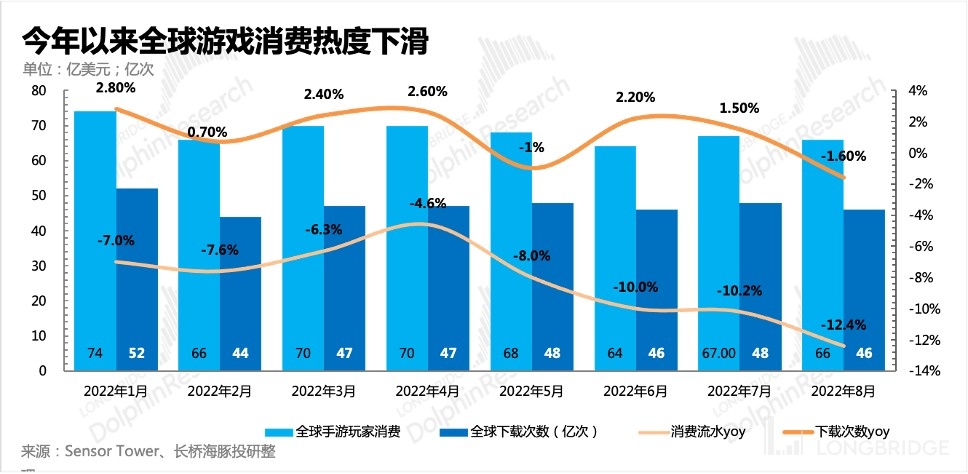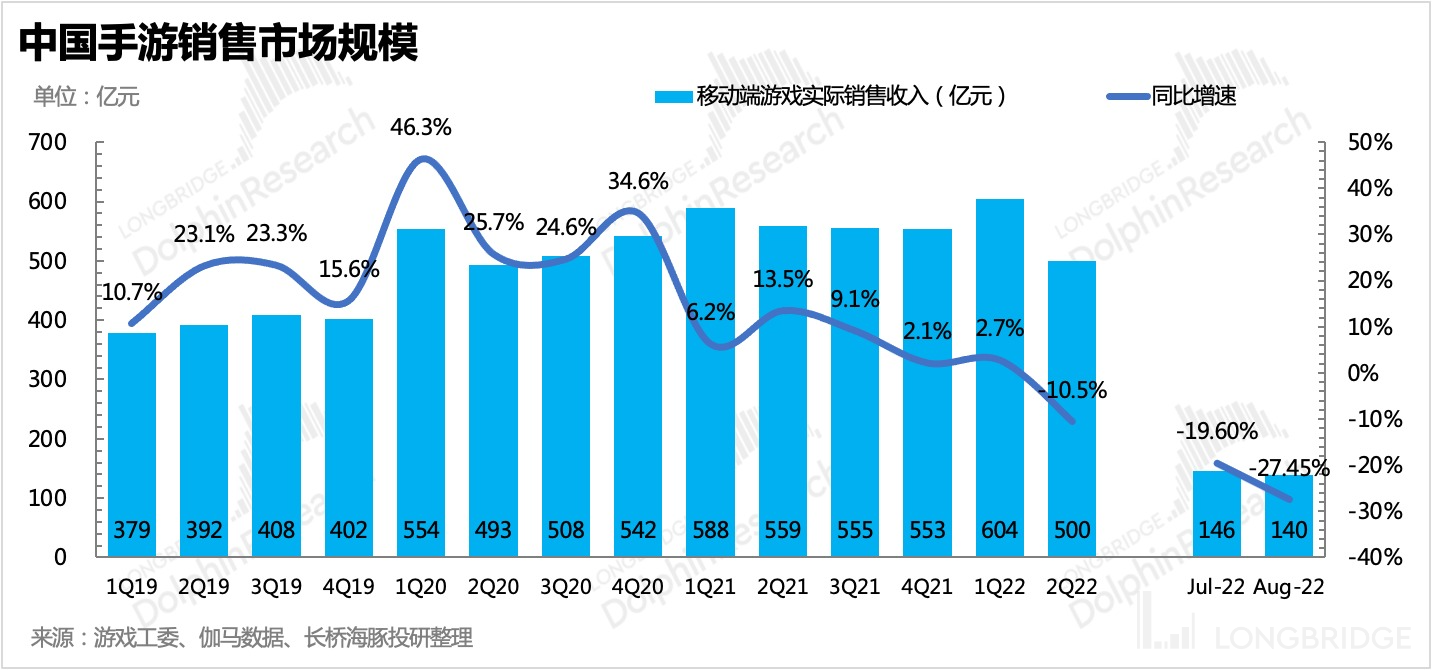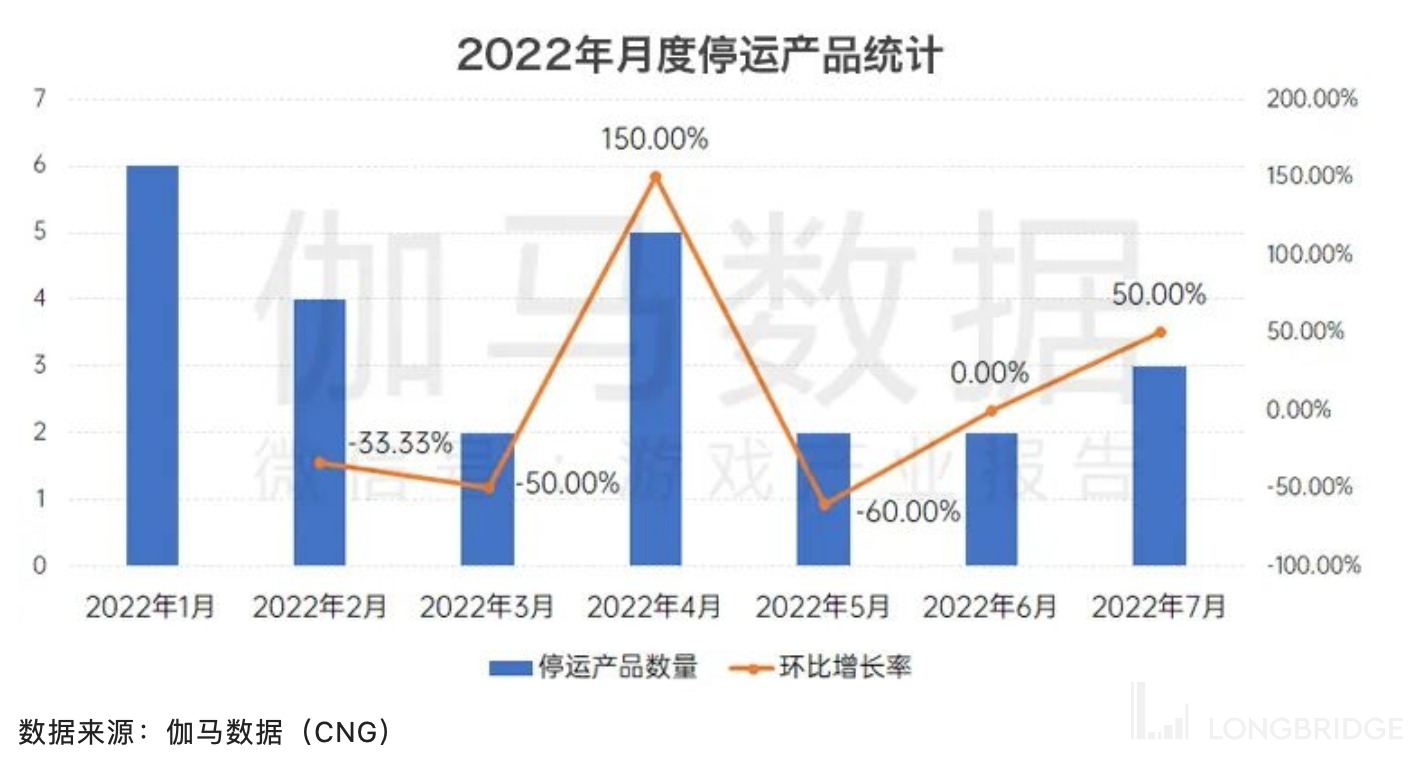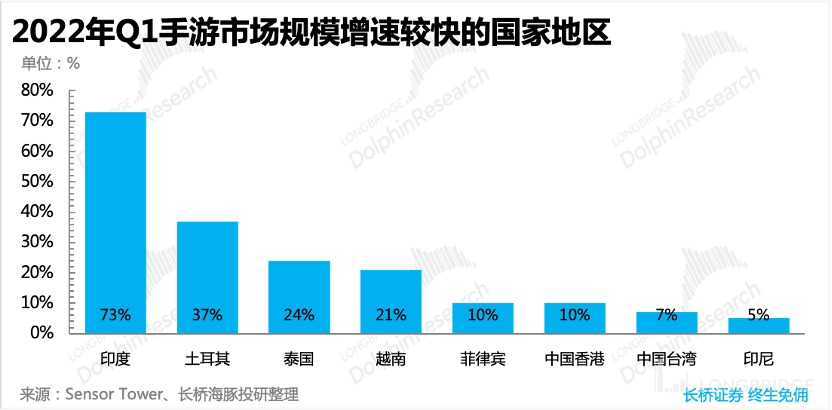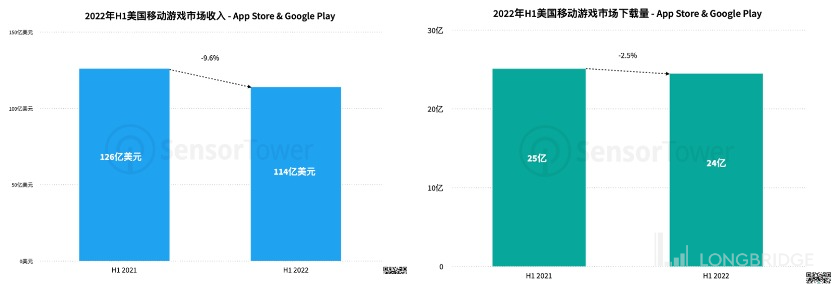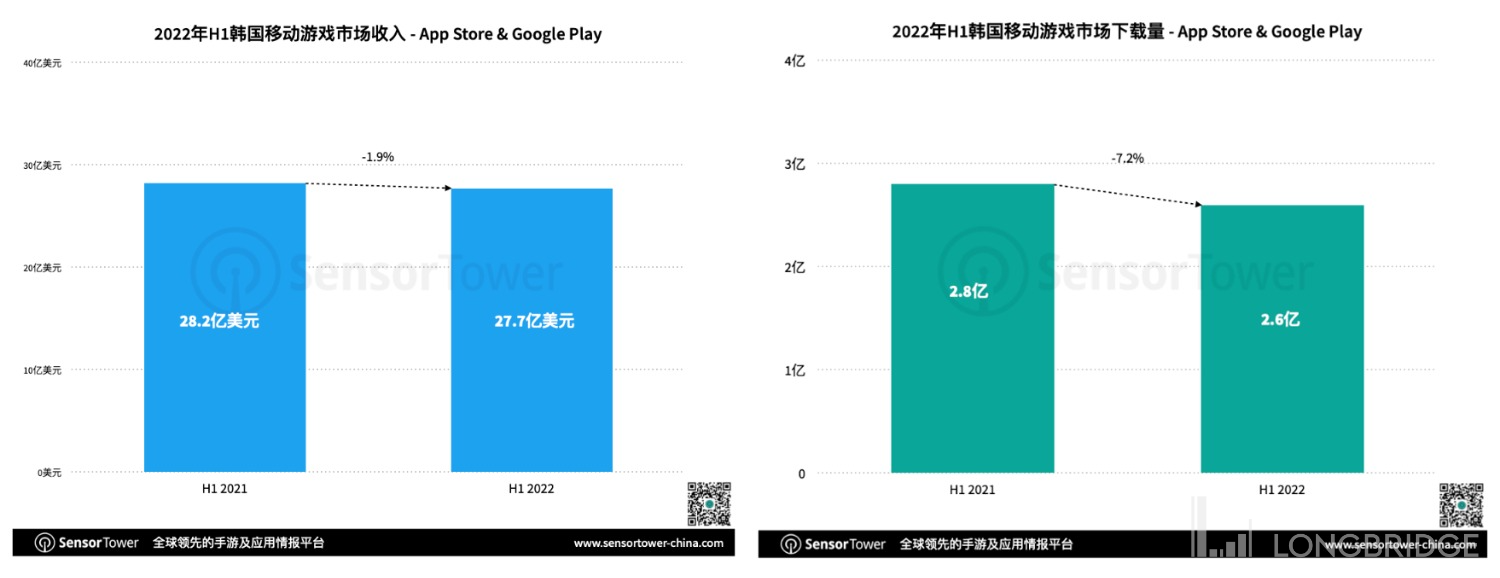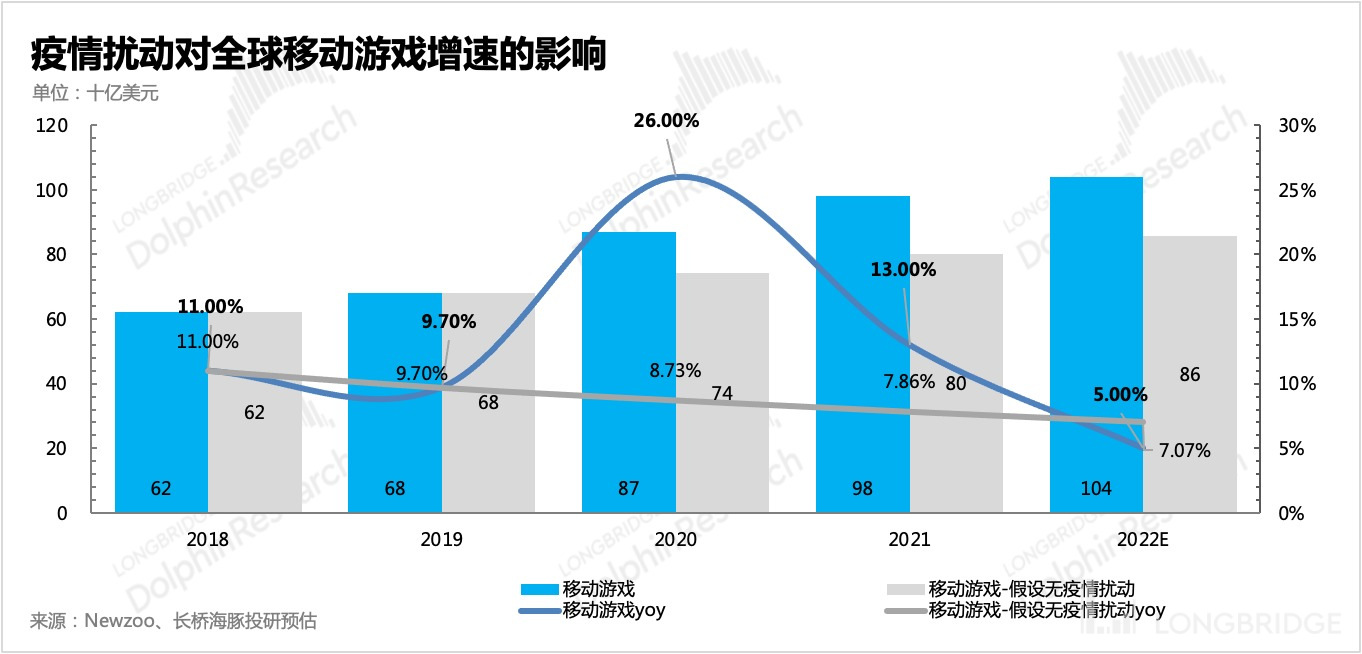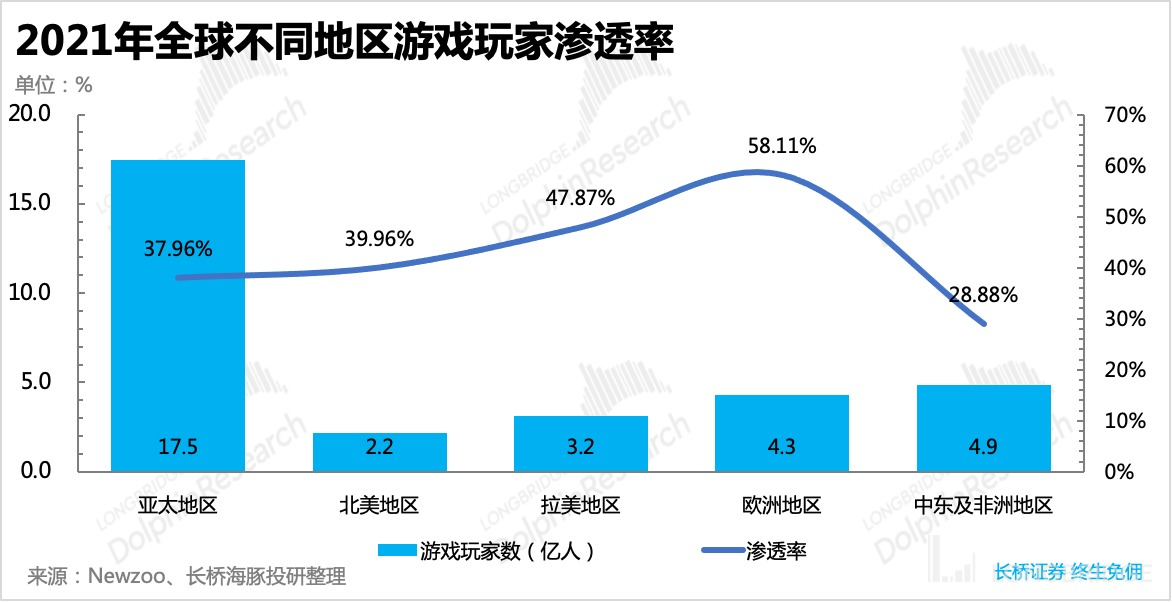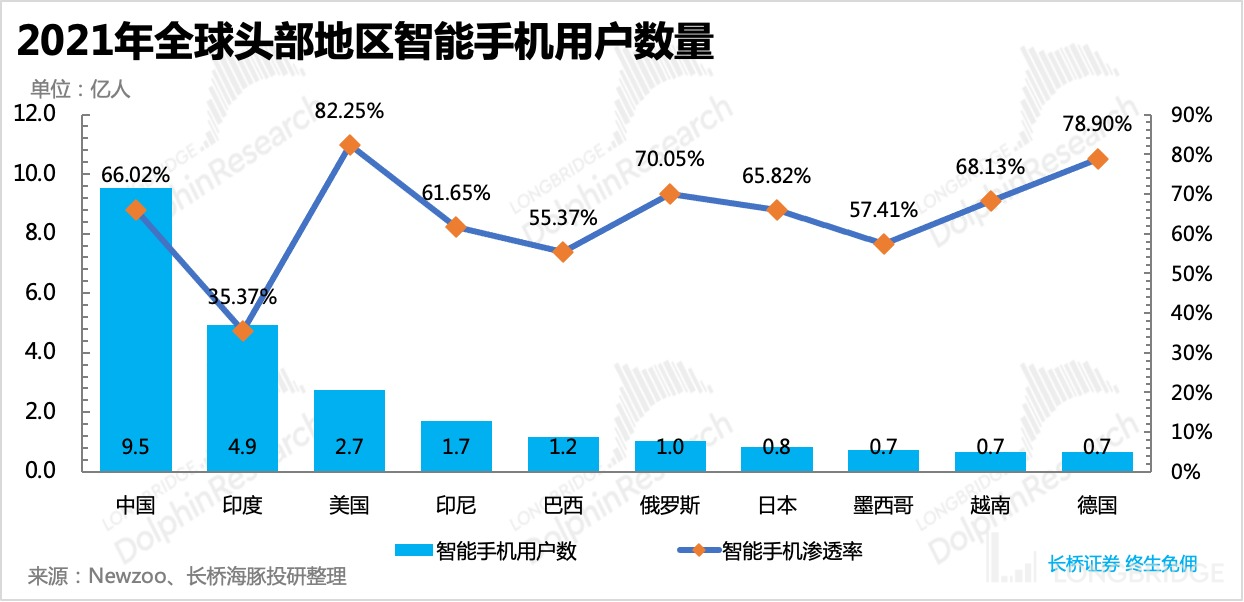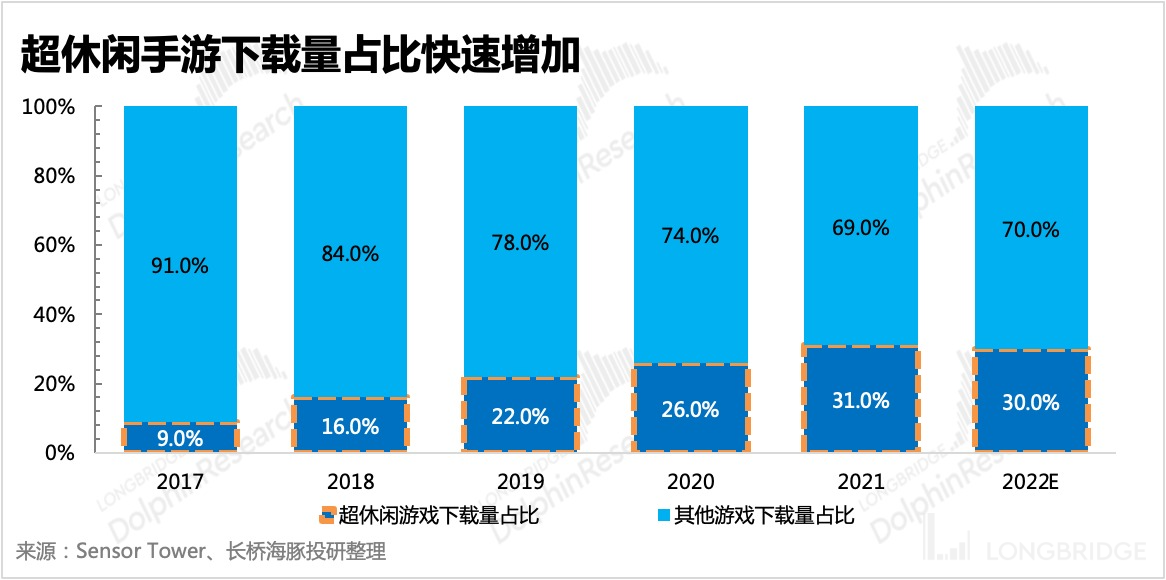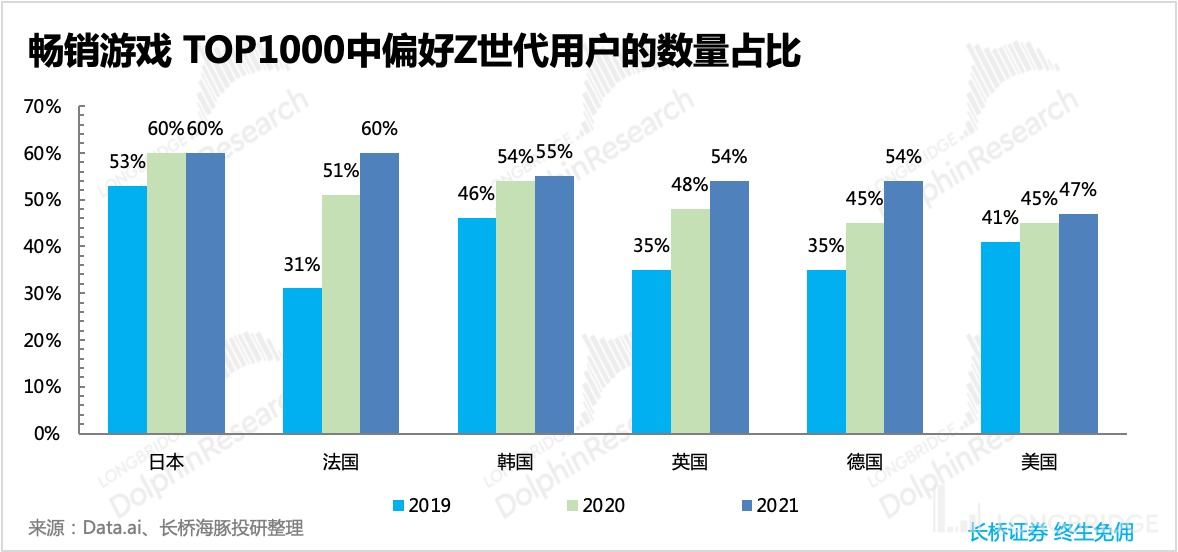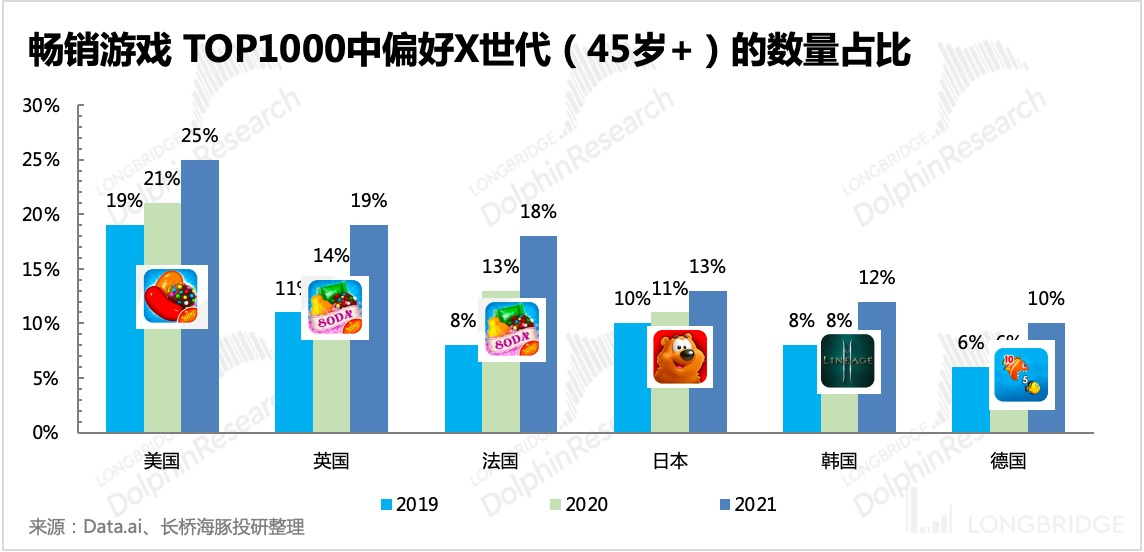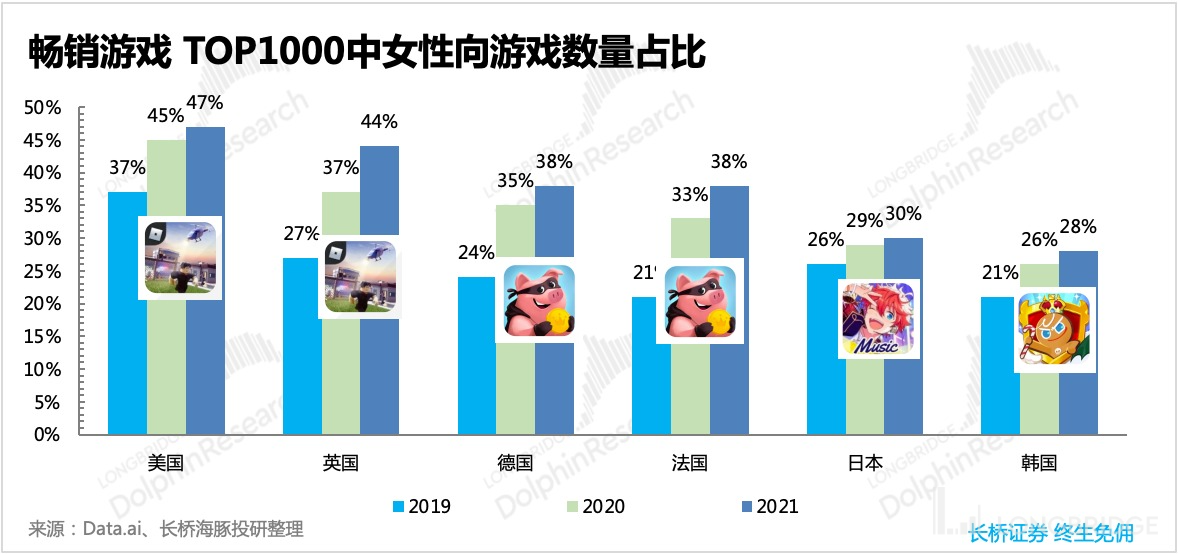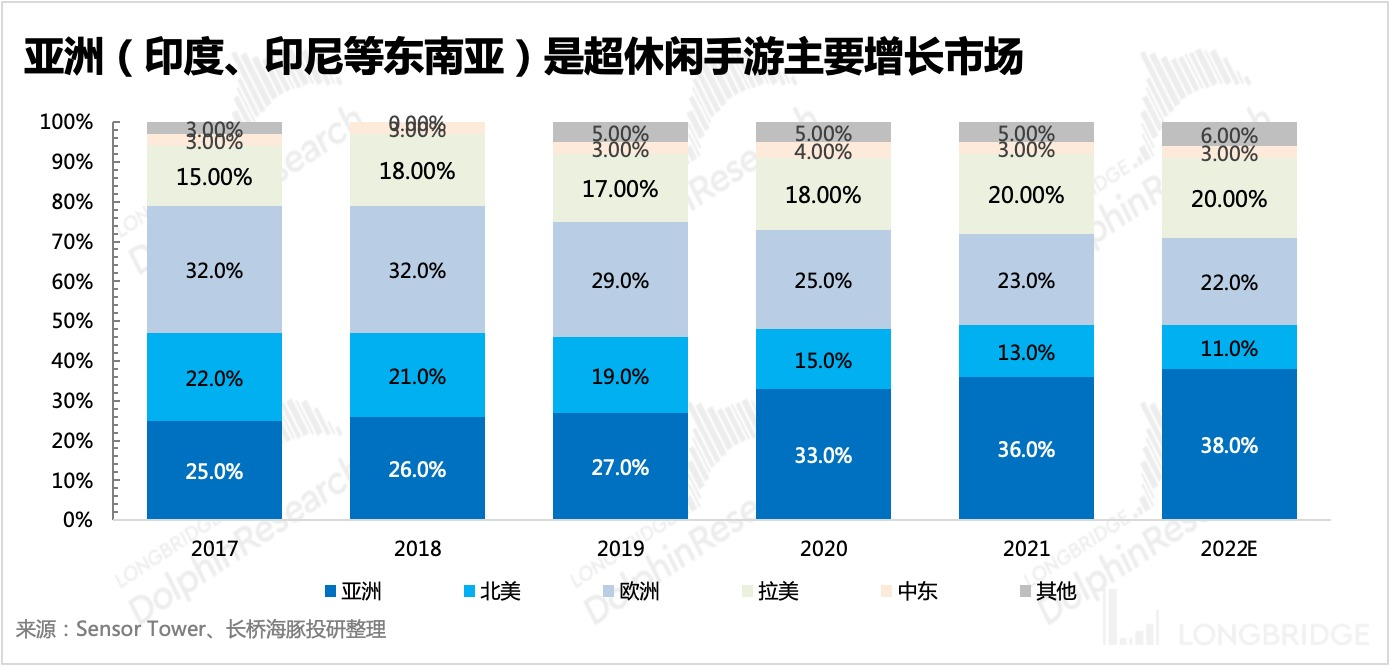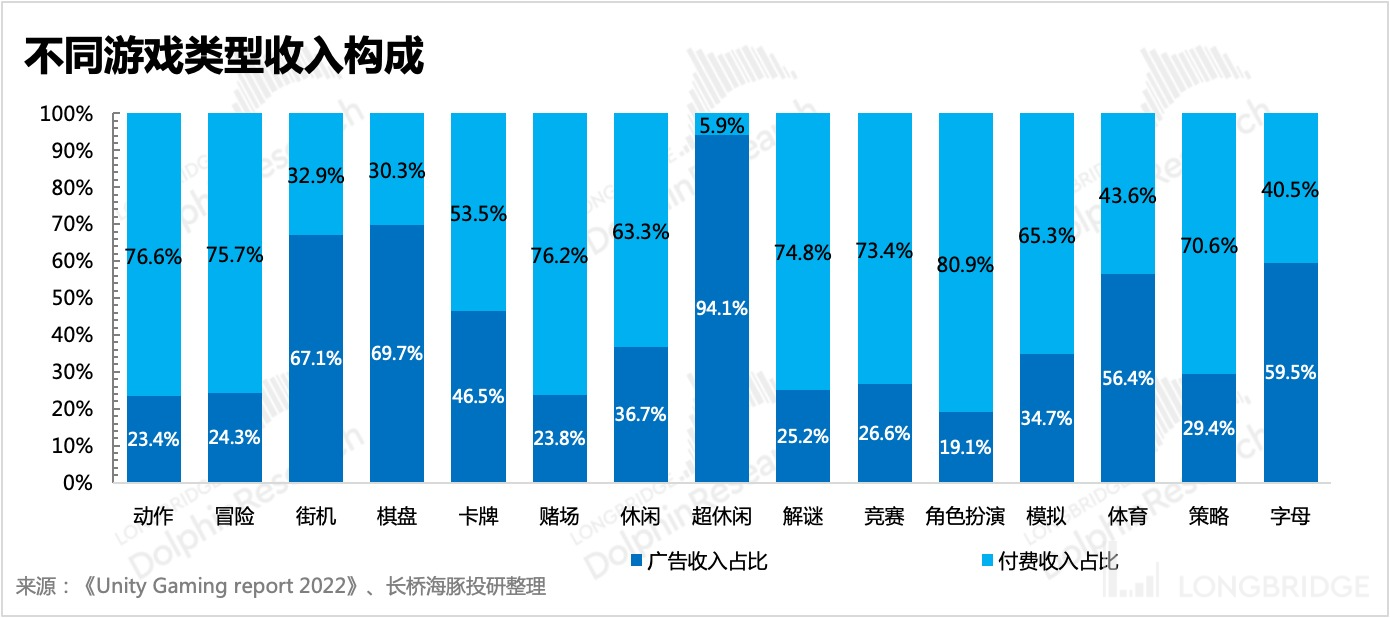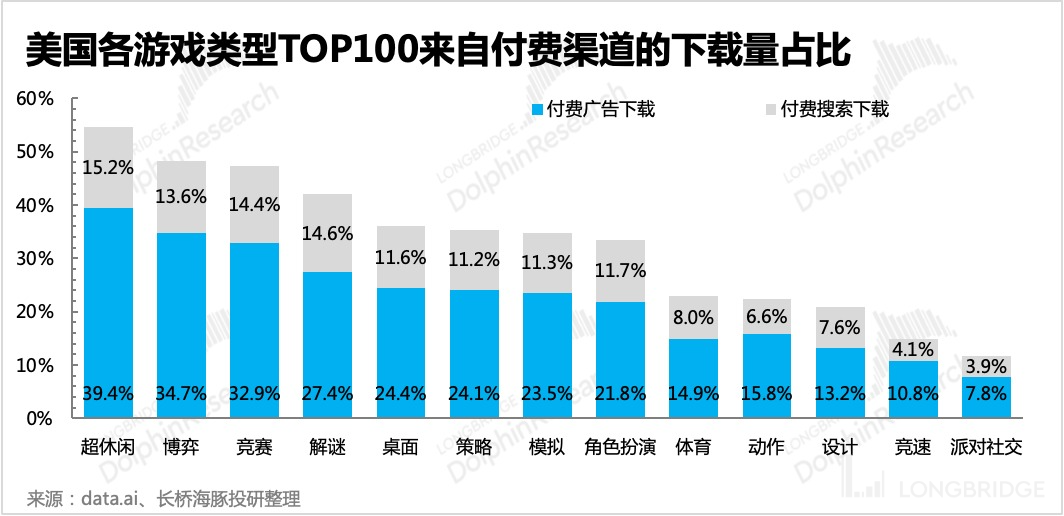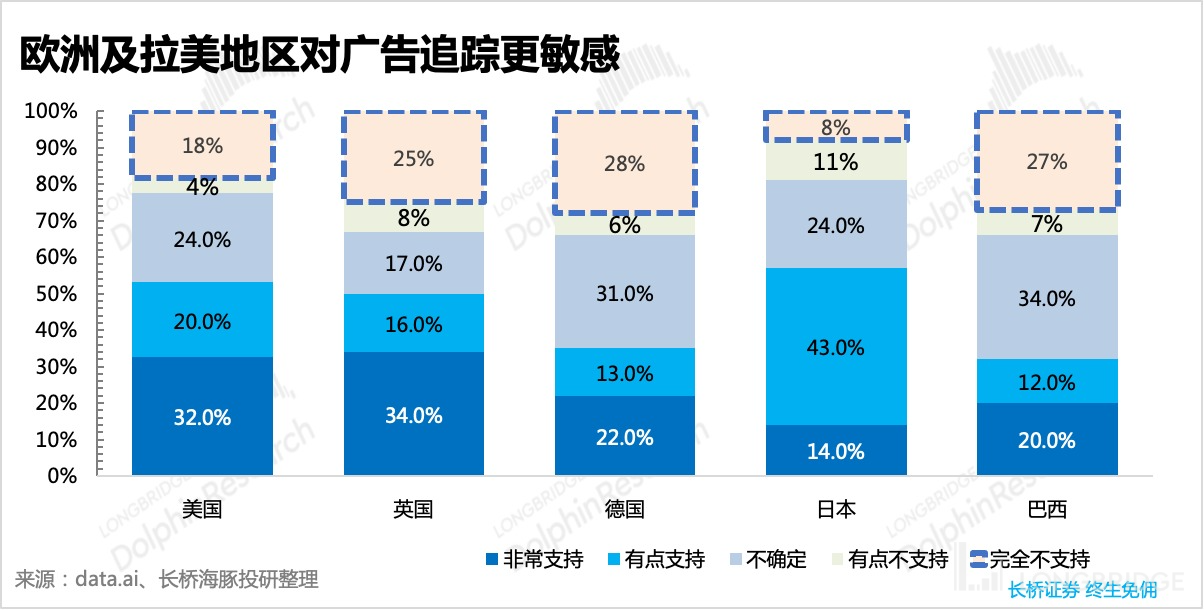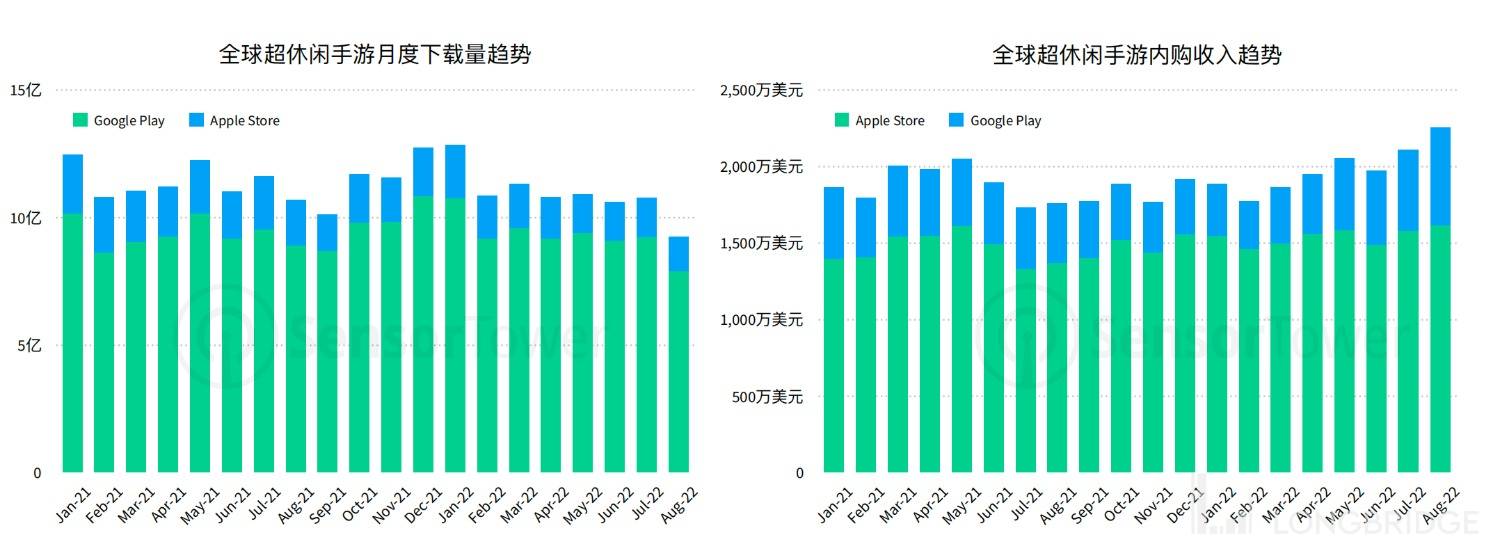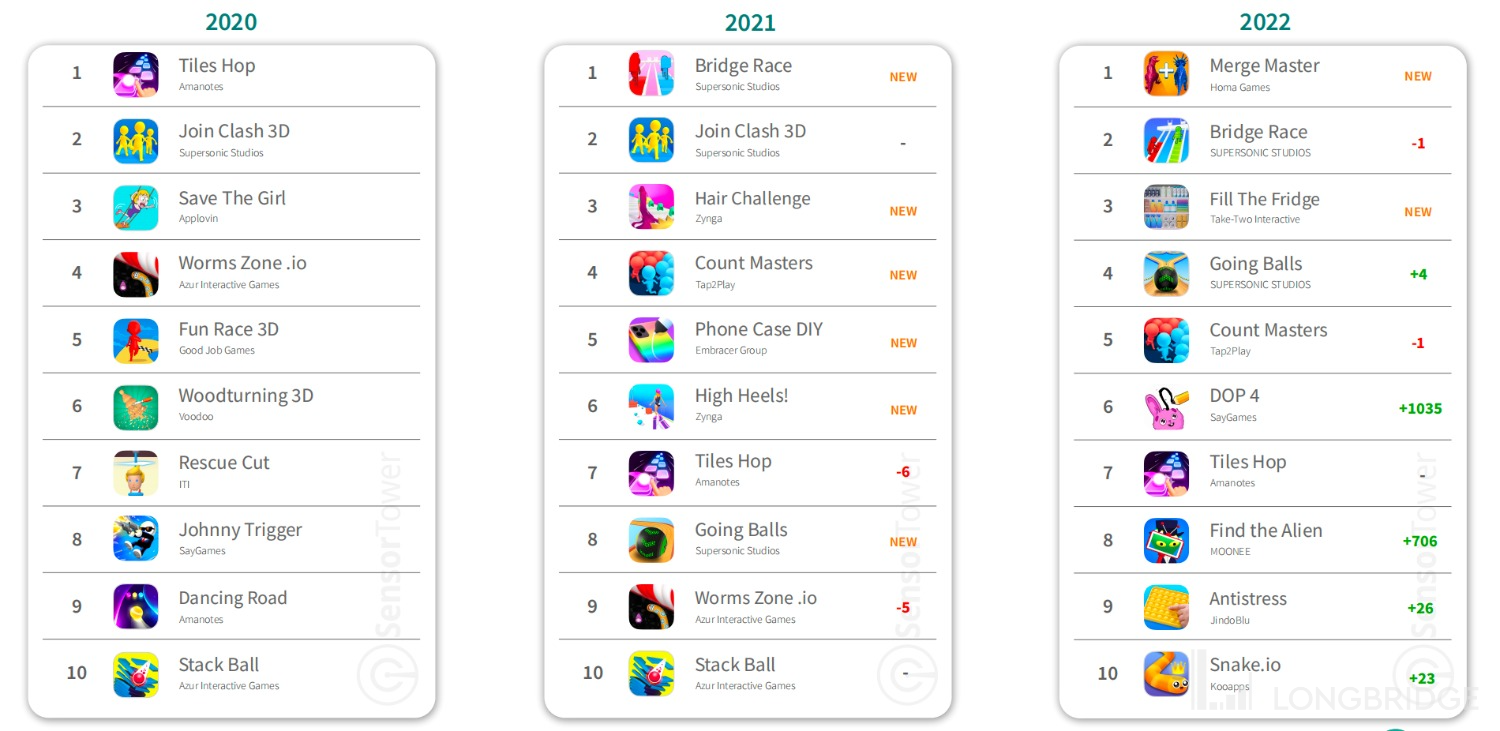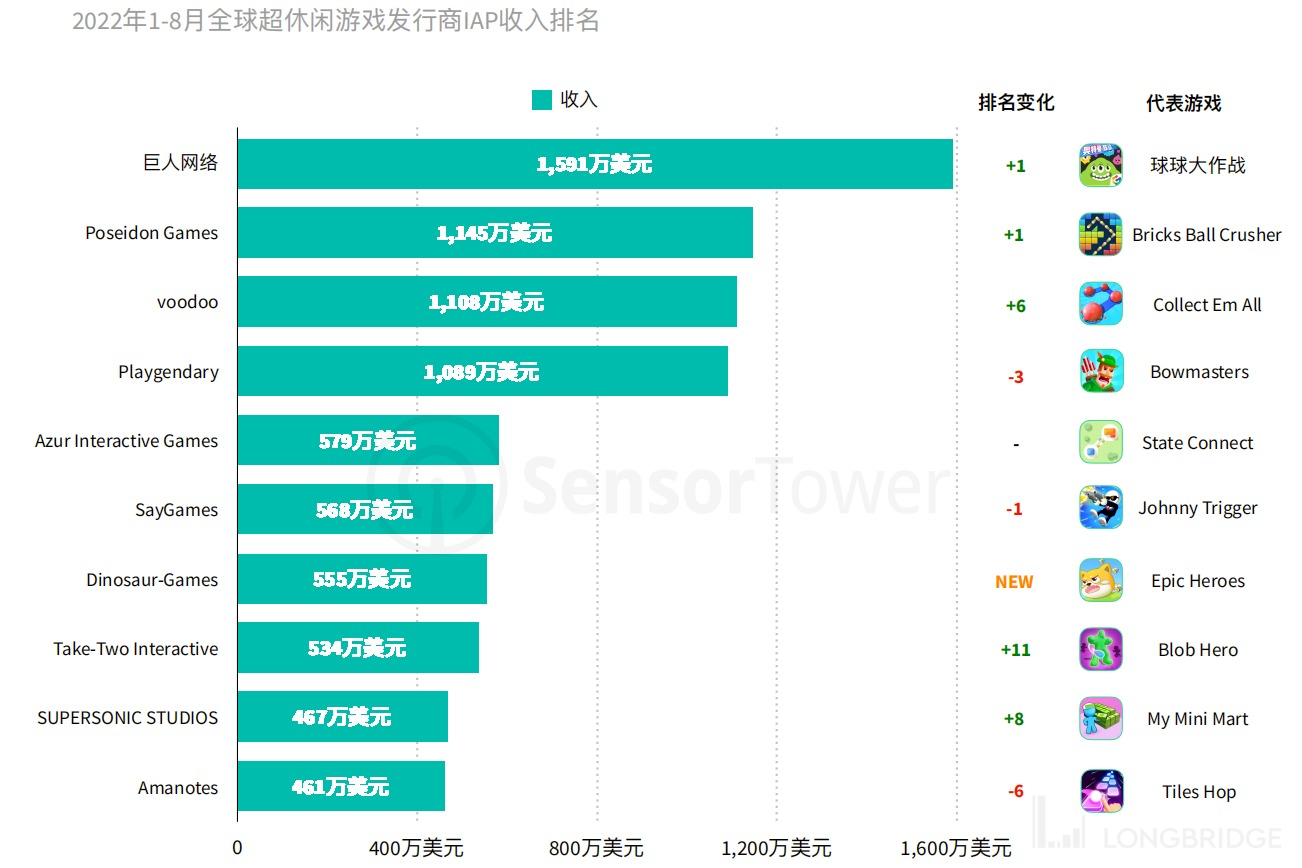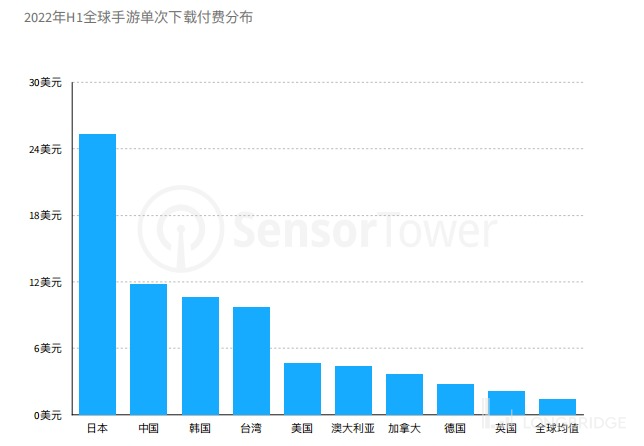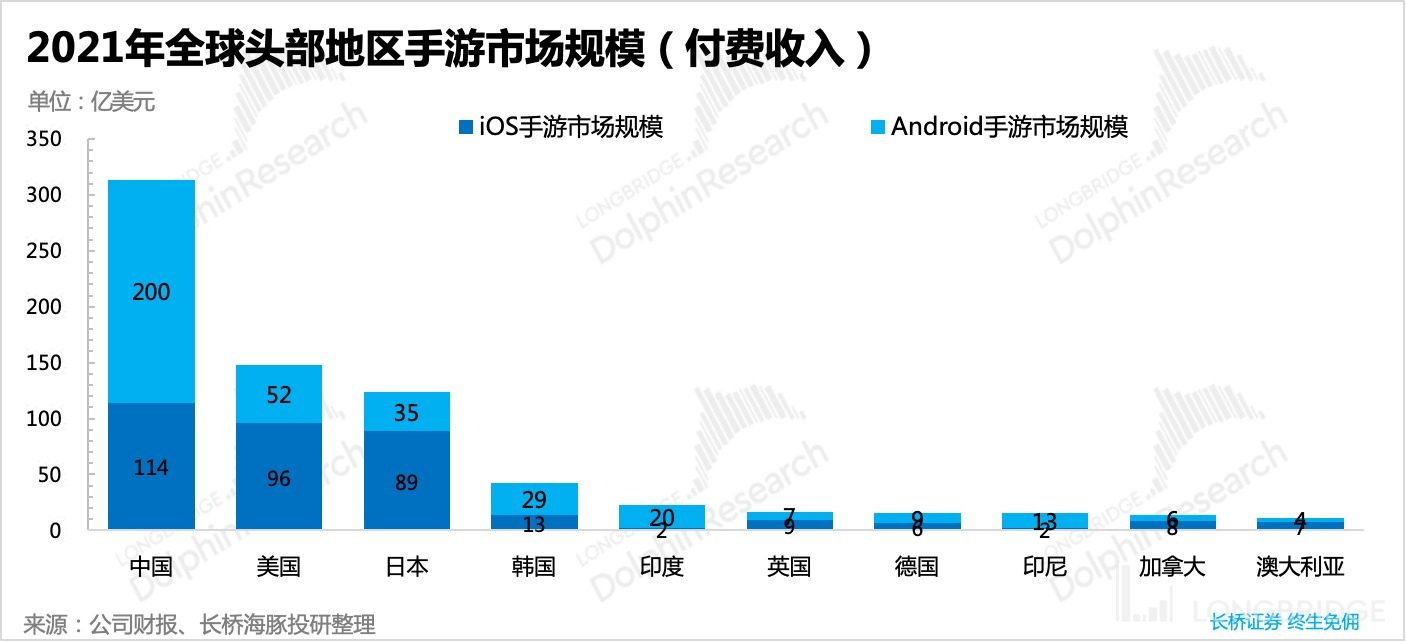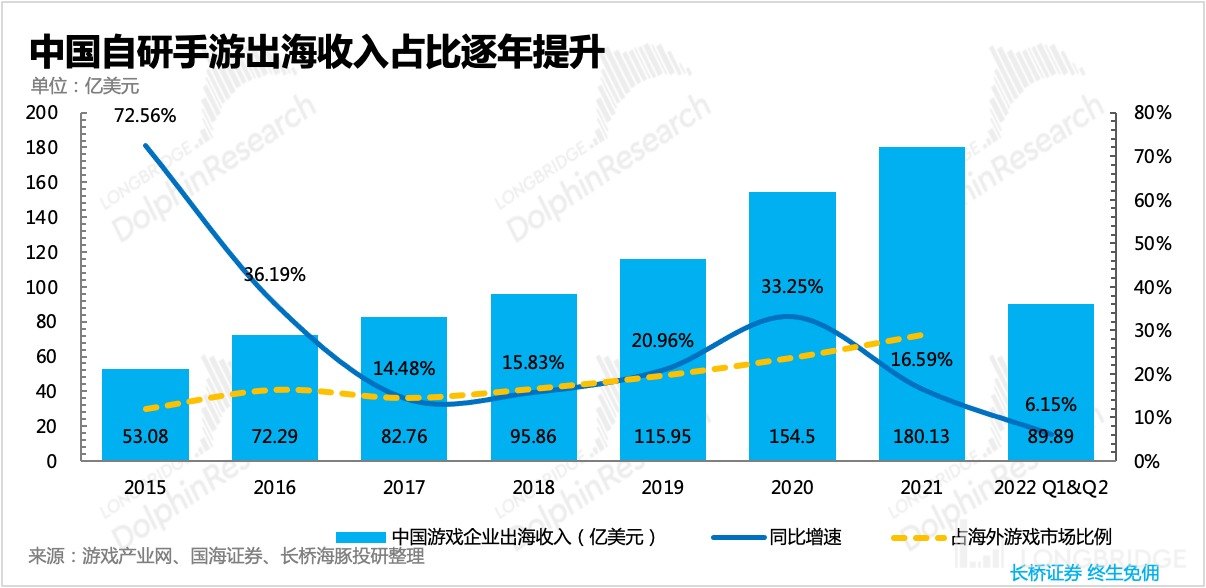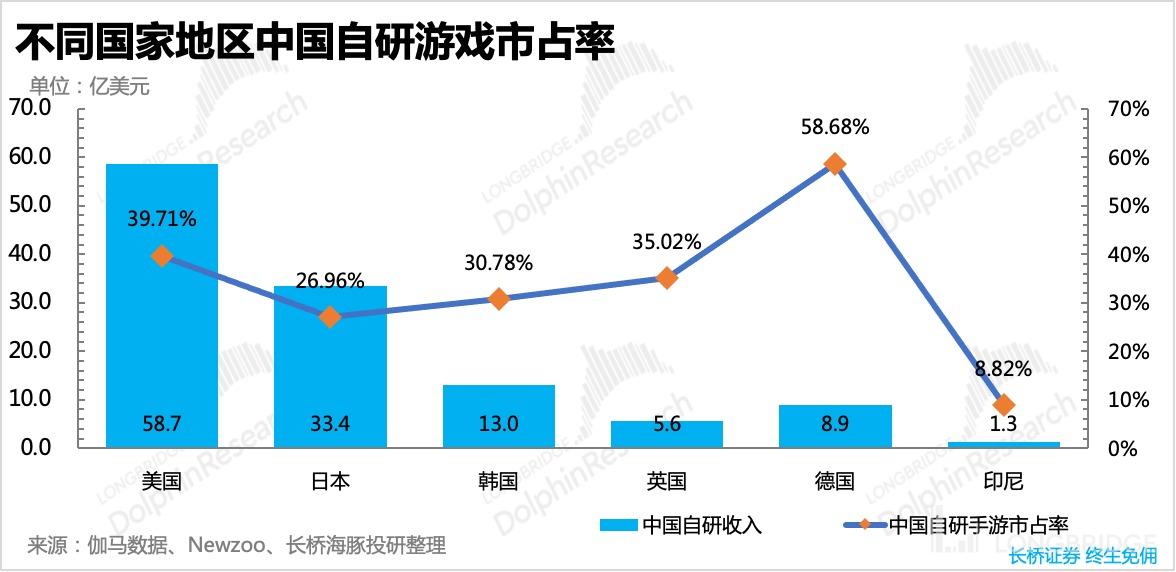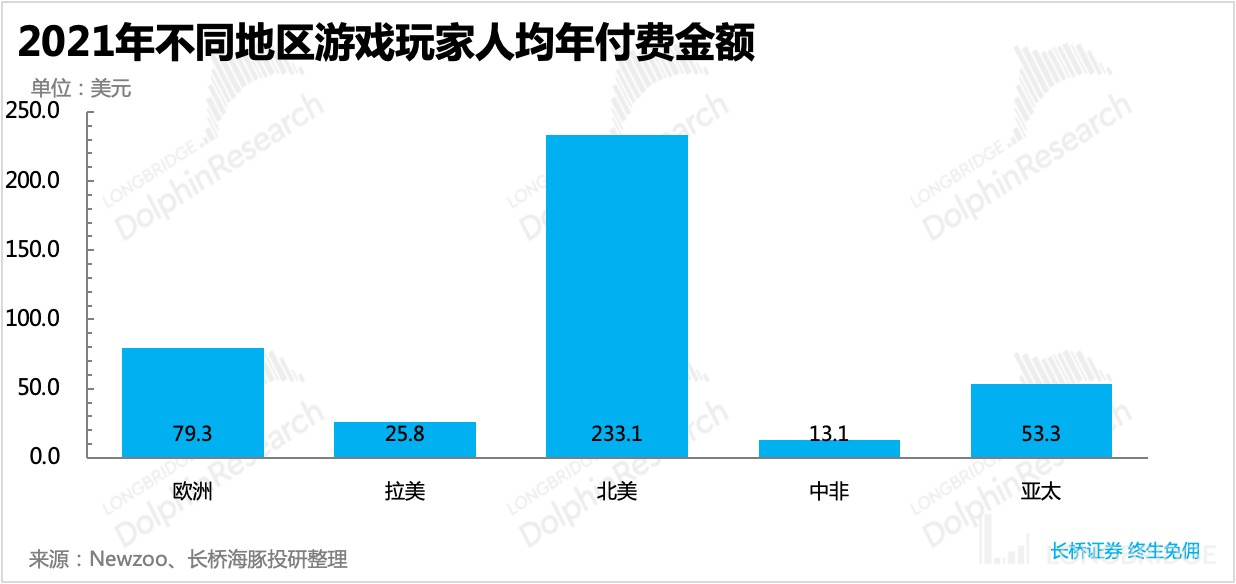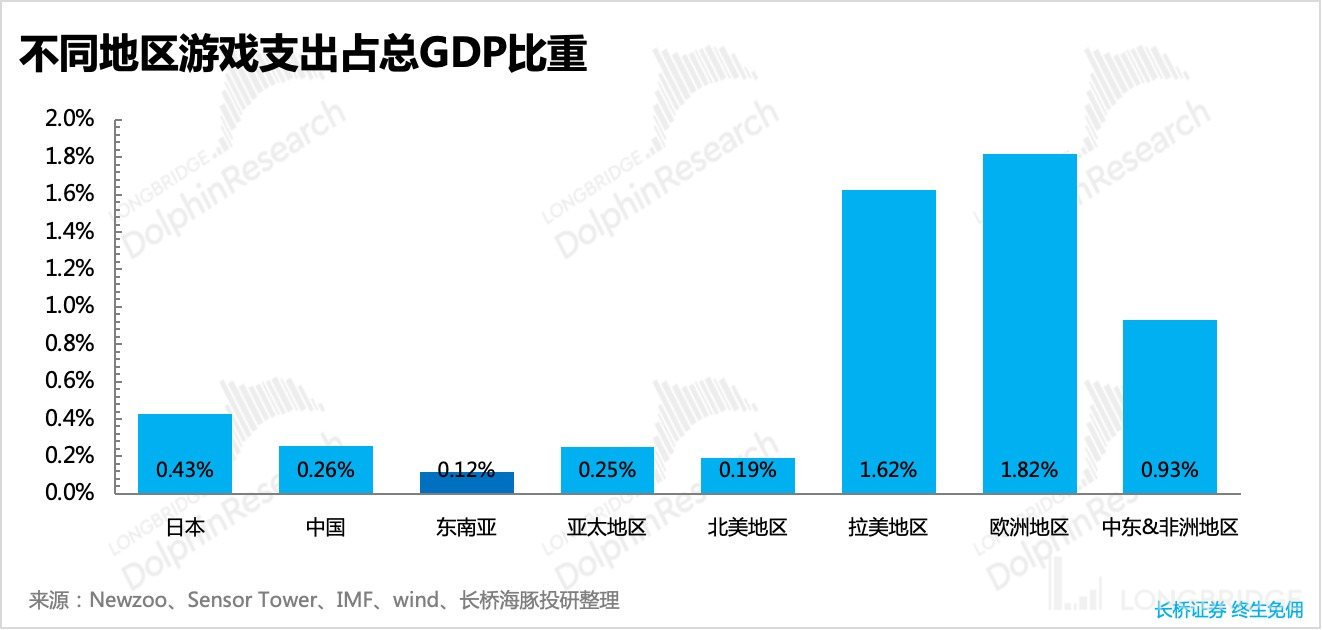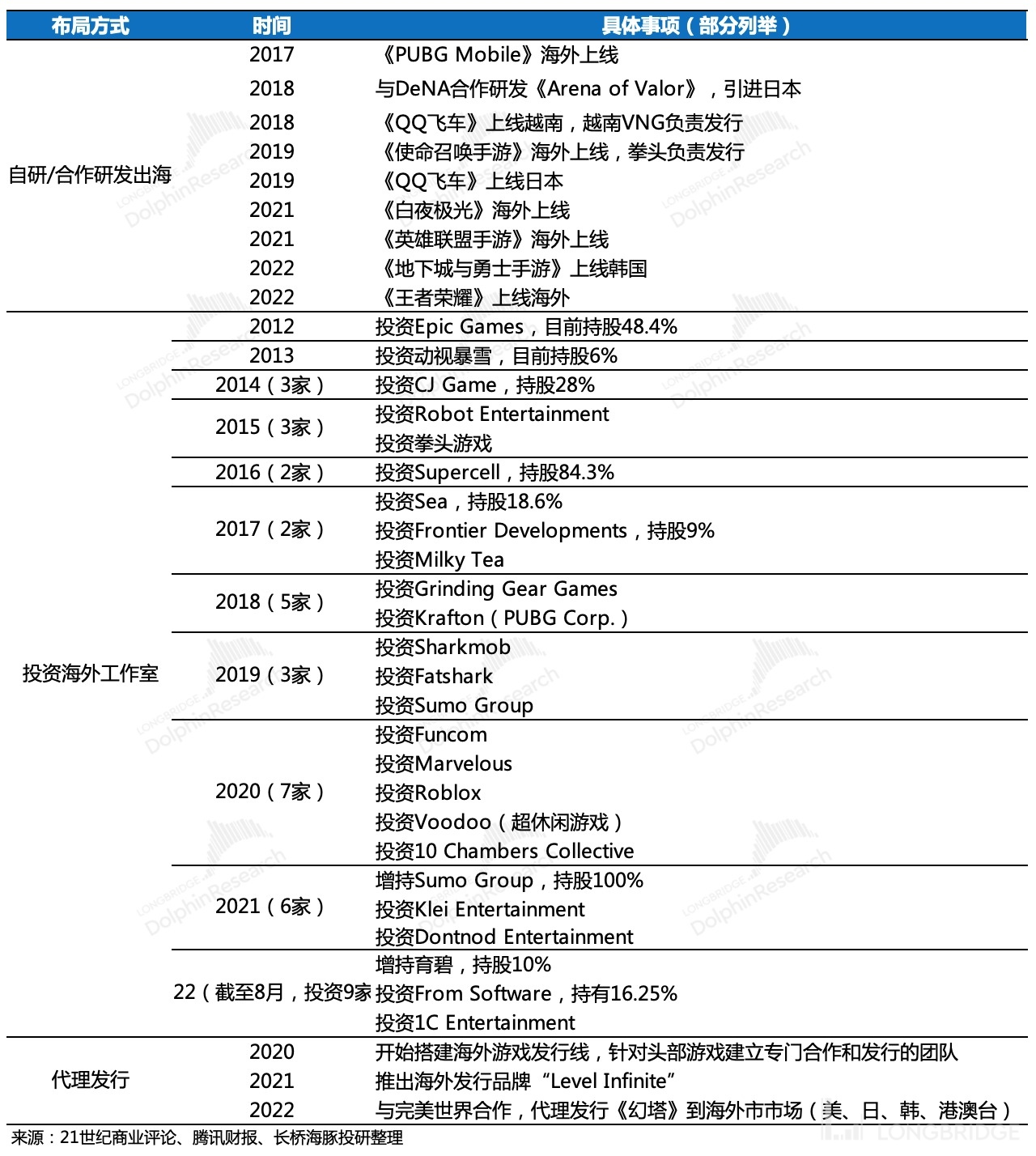The output cannot be provided as it requires interpretation. Please provide a text to be translated.
From the April edition, the last industry-related benefits in the short term have taken place, and the listed game companies seem to have fallen into an even more awkward situation. Although the number of publishing licenses has been reissued, the advantage in quantity for the original licenses has disappeared, and most of the games getting approval are casual games. Meanwhile, the difficulty in obtaining licenses for the medium-heavy games, which support the revenue growth of large and medium-sized companies, is increasing.
Therefore, under such new regulatory norms, game companies are actually stepping up their expansion abroad even faster than at the beginning of the year. The overseas market has become the card that many game companies, especially large ones, have to play, which means that overseas markets are the next battlefield.
However, the global game market is currently facing headwinds. In the post-epidemic era, in addition to the slowdown of the stay-at-home economy, inflation, recession, geopolitical friction, cultural conflicts, etc., all have added more obstacles and difficulties for Chinese game companies going abroad.
But if we look further, the vast potential market and the free creative environment also offer the opportunity for Chinese game companies that are more advanced in mobile game R&D, operation, and commercial strategies, to play a greater role.
Therefore, for the industry, although there are thorns ahead, it is necessary to go abroad.
However, for investors, the story of going global may not be as beautiful as the manufacturers advertised. At least the huge Chinese market is hard to find a second one. Before the new technology revolution arrives, market expectations need to be suppressed.
(1) The days when manufacturers with lowered abilities could lie in the gold mine and count money are gone forever, and the difficulty of making money overseas will only increase. After the short-term growth has disappeared, they will face the dilemma of accelerated contraction.
(2) The pressure for head manufacturers to grow further on the existing scale will be greater than the market originally expected.
When the game industry is struggling to pick up, Tencent's performance growth pressure is accelerating on WeChat. Furthermore, the need to invest more quickly in overseas games may further increase Tencent's motivation to sell equity assets.
For NetEase, the challenge is to find a new business curve before a return on valuation can be secured based on its content reserves. However, the desire to recreate a market in China (with overseas revenue accounting for 50%) is not an easy task.
Dolphin Analyst is dedicated to translating global core assets across markets for users, grasping deep enterprise value and investment opportunities. Interested users can add the WeChat account "dolphinR123" to join the Dolphin Analyst community to discuss global asset investment perspectives together!
I. In the post-epidemic era, the game winter has come.
Since the beginning of this year, I believe everyone's direct feeling about the game industry is that it has cooled down too quickly. Whether it is in China or overseas, game players seem to have stopped spending money overnight.
Taking the mobile game market as an example, the monthly mobile game data disclosed by Sensor Tower shows that global game revenue has shown a downward trend, especially after June, the decline rate has further increased.
 By country and region, the significant decline mainly came from the cooling down of the larger main markets (China, the US, Japan, and South Korea).
By country and region, the significant decline mainly came from the cooling down of the larger main markets (China, the US, Japan, and South Korea).
Firstly, let's take a look at China, as disclosed by Gamma Data. From Q2, the turnover of mobile games has gradually shifted towards a "panic-style" downward trend.

While economic depression and a decline in consumption will indeed affect players' willingness to pay, Dolphin Analyst believes the impact on the supply side is also significant. Although the game version has restarted, the negative impact on the industry's supply side has begun to emerge as capital budgets decrease due to uncertainty about the game version.
(1) On the one hand, new games that can be released since Q2 are almost blank, whereas during the same period last year, "Mole Manor," "Dream New Swordsman," "Douro's Continent: Soul Master Duel," "Marvel Super Wars," and other works by major manufacturers had excellent initial turnover. "Dream New Swordsman" was launched in July last year, and its monthly flow ranking entered the TOP10. However, only "Diablo Immortal" was in the TOP10 this year, but it was ranked last.

(2) On the other hand, due to the tightening of version number approval, project investment budgets have been cut, and many poorly performing old games have been shut down by various companies.

If we attribute domestic policies to the version number, hand-held gaming markets in major countries around the world, including China, the US and Japan, have seen faster declines in player payment size than in the first half of the year.
On the other side, in India, Indonesia and Brazil, countries with relatively low smartphone penetration rates and large population sizes, the overall mobile gaming market is still growing rapidly. However, due to the lower average payment level per person compared to Japan, South Korea and Europe and America, the global gaming market is showing a decline in revenue while the number of downloads is still growing, creating a "contradiction."
In addition, Hong Kong, Taiwan and other regions also grew in the first half of this year. Dolphin Analyst believes that this may be related to the rush of gaming companies going abroad during the discontinuation of mainland version numbers, resulting in their first station choices being in the Hong Kong, Macau and Taiwan region.
 2. Other Major Markets
2. Other Major Markets
(1) US Mobile Gaming Market: In the first half of the year, player spending decreased by 9.6% YoY, while downloads decreased by 2.5% YoY. Google Play users with relatively lower income faced greater pressure on living costs in the inflationary environment, resulting in significantly reduced spending on games.

(2) Japanese Mobile Gaming Market: User spending and downloads decreased by 12% and 11% respectively. Japanese players have the highest willingness to pay for games globally, although the number of mobile gamers is less than 50 million (according to ASCII "Fami-Tongame White Paper 2022"), the scale of the mobile gaming market ranks second in the world.
However, the Japanese gaming market is relatively mature and saturated, so overall growth is limited, and after the pandemic-induced overdraft, it is inevitable to return to normalcy.

(3) In the first half of the year, the Korean Mobile Gaming Market, which was filled with heavy new products, performed relatively well. Player spending decreased by 1.9%, and downloads decreased by 7.2%. New games such as "Heaven W," "Dungeon & Fighter Mobile," "Diablo Immortal Mobile," and "Uma Musume" have performed strongly, especially driving the increase in the scale of iOS user spending, which is already relatively high, partially offsetting the decline in the Android market.

Overall, the decline in mobile gaming markets is due to the following reasons:
1) Demand-side: It is mainly related to the global relaxation of the blockade and macroeconomic factors, especially the suppression of optional entertainment demand in areas with high inflation. Part of this is actually digesting the impact of overdrawing future growth during the epidemic.
Assuming that there was no epidemic and the disturbance caused by the epidemic on the economic cycle, smoothing the market growth rate before the epidemic in 2019 linearly (the annual growth rate gradually decreased by 90%), from the trend, due to the overdraft during the epidemic, if it returns to the original growth channel this year, it will also face a 10-15% decline (=860/980-1).

2) However, Dolphin Analyst believes that the impact of the supply-side should not be underestimated in the short term, which is perhaps an area where market attention is not high enough. a. During the peak period of the epidemic in 2020 and 2021, periodic work-from-home policies will significantly reduce the productivity of game companies, thereby affecting the supply of game products this year.
Any mobile game has its own ebb and flow, and therefore the overall market growth relies on a continuous introduction of new products. As can be seen from the development of different markets mentioned earlier, in regions where new products are lacking, the decline in players' consumption desire will be greater.
b. Lack of budget not only affects the supply of new games, but also affects the supply of old games. In the case of limited budget during the capital winter, game manufacturers will consider the input-output efficiency, they will timely shut down some games with poor ROI performance, and also raise the standard for new game projects. This also reduces the number of games on the market.
2. Industry growth: who is the "Hope of the village"?
If you want to see the future growth of the gaming industry, it can only be viewed from two perspectives, which are the expansion of the number of players and the increase in players' payment power.
(1) The expansion of the number of players: on one hand, it is the further penetration of gaming hobby, the adoption of game consoles in families where the epidemic is deepening, and the increasing penetration rate of intelligent mobile phones in some regions, as well as new devices brought by technological innovations, such as VR, AR, and so on, as mentioned in Dolphin Analyst's VR report "The Redemption of Goerl: Pico with Byte" published yesterday.


(2) The increase in players' payment power: In the short term, it is difficult to escape the impact of the big environment of economic downturn after inflation pressure. Only some regions will have structured growth opportunities.
At present, users in Europe, America, and East Asia have the highest paying power. However, compared with the country's overall GDP, the proportion of game payment in the Asia region is still not high. From a cultural perspective, outside of East Asia, there is more payment potential to be tapped in other Asian regions (Southeast Asia and South Asia). In the medium and long term, as globally outstanding game manufacturers output products to these regions, local users' demand for games will be further stimulated.
The game spending rate in North America is not as high as expected, and there are also possibilities for further development. However, although Latin America and Central Africa have had good growth rates in recent years, due to the low average income of residents, the current game market development is still relatively sufficient in relation to the current economic level.

1. Short-term Increment: Tiny Hyper-Casual Games Can't Save the Day, but Can Help Break the Mold
Looking at different game categories, the fastest-growing in recent years are hyper-casual games, primarily featuring obstacle crossing, puzzle solving, simulation, etc. Dolphin Analyst believes that although the hyper-casual market is still quite small, its outbreak is due to specific reasons during the pandemic, which can have a long-term impact and assist the overall gaming market.

(1) The Driving Force Behind the Outbreak of Hyper-Casual Games - "Breaking Free from Gamers' Conventions"
Compared to medium-to-heavy games that require effort to explore payment points and increase prices, the growth of hyper-casual games in recent years is more logic-driven towards quantity.
a. During the peak of the pandemic and global lockdowns (2020-2021), most user activity shifted online. Because hyper-casual mobile games have very low barriers to entry and are more flexible and convenient, they captured many non-gaming players, such as some middle-aged users and female users who penetrate from hyper-casual to casual.
In different country markets, the proportion of best-selling games trending towards Generation X users (45 +) in the top 1000 positions is increasing rapidly, while before the pandemic, Z-generation users had the fastest-growing games.
Game styles most popular among women during the pandemic are simulation, adventure, development, music, and other casual styles, such as Roblox, Coin Master, and Ensemble Stars Music.
The most favorite games for middle-aged users during the pandemic are still candy crush, fishdom, and other matching games.


 b. The monetization methods of hyper-casual games include not only player payments (download payments, props payments), but also in-game advertisements (banner advertisements, video incentive advertisements, etc.). The monetization method of in-game advertising conforms to the characteristics of mild game players with low willingness to pay and low payment ability in specific countries and regions.
b. The monetization methods of hyper-casual games include not only player payments (download payments, props payments), but also in-game advertisements (banner advertisements, video incentive advertisements, etc.). The monetization method of in-game advertising conforms to the characteristics of mild game players with low willingness to pay and low payment ability in specific countries and regions.

Overall, hyper-casual games have significantly expanded the range of game users in terms of age and consumption level through the methods of "reducing thresholds" and "advertising replacing payments".
(2) The growth momentum of hyper-casual games: Advertising encounters App privacy policy interception, and the future still depends on in-app purchases.
Since hyper-casual games are more inclined to have large DAUs, this type of monetization, such as in-game advertising, will naturally appear in casual/hyper-casual games. Similarly, casual games will also use this method to attract users.
According to Unity's game report, at present, 95% of the revenue from hyper-casual games comes from advertising, and only 5% comes from player payments. At the same time, the majority of hyper-casual games obtain users through paid advertising, with 55% of downloads from paid channels, most of which are obtained through paid advertising.


If the in-app purchase revenue of hyper-casual games in 2021 disclosed by Sensor Tower is calculated at 2.3 billion US dollars, and the proportion of the above in-app purchase revenue is 5.9%, then the overall market scale of hyper-casual mobile games in 2021 is approximately 4 billion US dollars, which is only 4% of the overall mobile game sales revenue (980 billion, Newzoo).
Although the market size will be reduced by large players in India, Indonesia, and other countries, it is still in the early stage of development considering its download proportion of only 30%.
However, after Apple's ATT was officially launched in the second half of 2021, especially among European and American users who have relatively strong privacy awareness, most people will choose to turn off App's data tracking technology. This has greatly affected the casual games that rely on advertising from other applications to obtain users and generate advertising revenue.
 In addition to industry supply being affected by declining productivity, game-buying revenue will also show a shrinking trend, which will in turn affect the IAP revenue of casual games. After one of the advertising revenue streams is cut off, the short-term growth potential of hyper-casual games depends on in-app purchases.
In addition to industry supply being affected by declining productivity, game-buying revenue will also show a shrinking trend, which will in turn affect the IAP revenue of casual games. After one of the advertising revenue streams is cut off, the short-term growth potential of hyper-casual games depends on in-app purchases.
At present, players have low willingness to pay for hyper-casual games. Compared with other games, the amount of in-app purchases per download is extremely low. This is related not only to the commercial model design of the game, which focuses on advertising, but also to the limited payment ability of players in Southeast Asia, Latin America, and other regions. However, in relatively developed regions such as Europe, America, and East Asia, after the growth of in-game advertising is affected by Apple and Google's privacy policies, the high payment ability of players in these regions may be stimulated by manufacturers' adjustment of the commercial model.
For example, in the US market, the proportion of games that tilt towards Generation X (45+) in the top 100 is rapidly increasing, and this group of users controls 80% of the wealth in the entire United States. When more Generation X users are developed into game users, their purchasing power may bring considerable growth to casual games.
Chart 1

(3) Pervasive Competition: Not Every Company Can Eat Direct Dividends
Although the casual game market is full of imagination, the cost of imitation and plagiarism is very low due to the relatively simple content and gameplay design, and the speed of user interest migration is faster. Therefore, for manufacturers who make casual games, if they do not have strong publishing, channel promotion, and long-term operation capabilities, the product's life cycle will be greatly shortened in the pervasive competition.
In the ranking of annual hyper-casual game downloads released by Sensor Tower, the top products change very rapidly. There are new products that are short-lived, and old products that have returned to the limelight due to product updates and strong operations.
In such a fiercely competitive market, for small factories or small studios, making one profitable game is already enough. However, for large factories, it is too difficult to contribute a significant increase on its existing scale by relying on hyper-casual games.
Chart 2

In a list of revenue rankings for hyper-casual game releases in January to August 2022 released by Sensor Tower, the first place goes to the Chinese giant network, which achieved revenue of 15 million US dollars. This earning ability is not even as good as the level achieved by Diablo Immortal within a week of its launch. Therefore, hyper-casual games are only suitable for small and medium-sized factories, and big ones do not find their way out here.

3. Long-term Increment of the Industry: Waiting for Technological Revolution (VR/AR, Cloud Gaming)
The long-term increment of gaming comes from the wave brought by technological revolution. The visible ones for now are cloud gaming and VR/AR gaming. However, the process of technological revolution is always full of twists and turns. Regardless of cloud gaming and VR/AR gaming, they are still in the phase of basic user penetration of hardware and software.
Although the user education is not complete and the stage of content prosperity is far away, the new era is approaching, and the online economy accelerated the industry's progress due to the COVID-19 pandemic. It's a completely new market and has a lot of differences in user scenes, habits, content forms, and ecological patterns compared to the current market. However, as this content is viewed from the perspective of the short to medium-term (1-3 years), Dolphin Analyst will not expand on this topic now, but will set up a special topic to discuss it later, so please stay tuned.
3. The Current Situation of Excellent Chinese Gaming Companies' Overseas Expansion
To be honest, Dolphin Analyst discovered that despite the increasingly stringent approval process for version numbers and two devastating suspensions since 2015, China is still an attractive gold mine market globally. Due to its population size and the users’ high payment ability, both the quantity and price are substantial, and it is a big enough market. Therefore, for gaming companies, making money here is more comfortable.


However, with culture control becoming more stringent and policy supporting overseas expansion, it seems that going abroad is an inevitable step. However, few companies can completely give up this gold mine in the Chinese market, especially those pursuing higher revenue scales.
Therefore, although the large gaming companies’ moves to go overseas are vigorous, from the perspective of investment concerns for performance growth, we have to admit that the sales performance of gaming in China is still the biggest factor affecting the market's capital for gaming stocks in the short term.
The vision of big companies for overseas gaming revenue accounting for more than 50% is mainly based on a long-term perspective. The long-term depends on how much investment companies are willing to make and how much overseas markets will accept. If they encounter some sanction policies under the regional decoupling trend, such as India's boycott of Chinese apps, the uncertainty of realizing the vision will also increase. For investors, in the current market environment, it still requires more attention to marginal changes and risk-reward ratios in the short term. Above are some musings from Dolphin Analyst, now let's get back to the topic of China's companies going global.
There are three main ways that Chinese gaming companies are expanding into overseas markets: developing and releasing their own games, acting as agents for foreign games, and directly acquiring overseas game studios.
1. Developing their own games for the global market
Generally, aside from games with strong Chinese cultural elements or a focus on the Greater China region, most gaming companies, big and small, will try to promote their own games abroad. Dolphin Analyst has learned that, especially since the suspension of game approvals last year, Chinese gaming companies have been formulating strategies to go all out in expanding into global markets. In addition to modifying existing games to better align with the consumption habits of overseas users, companies are also speeding up their efforts to focus on projects that cater to international audiences. Therefore, developing their own games for the global market is likely the most popular strategy at the moment.
Gaming is a major pillar of Chinese culture's foray into overseas markets, and in recent years, Chinese gaming companies have increasingly wielded their power in international markets thanks to their relatively advanced mobile game development capabilities.
Some of the most successful Chinese gaming companies expanding globally in this way include Tencent, miHoYo, NetEase, Lilith Games, FunPlus, IGG, ELEX, and Century Huatong, among others.

2. Is Southeast Asia's market highly competitive? Only time will tell
Currently, the main overseas battleground for Chinese gaming companies is in mature markets such as Europe, America, Japan, and South Korea, where players have strong spending power.


However, as we have seen from our earlier comparison, Southeast Asia remains an potentially untapped region with the greatest potential for growth in gaming spending. Latin America has a relatively high proportion of its gaming industry, but overall growth in the industry is more reliant on economic stimulation. South Asia, dominated by India, may have a population advantage, but due to resistance to Chinese businesses and greater geopolitical risks, it is not a stable environment for growth.
While it is true that we have seen an increase in Chinese gaming companies expanding into Southeast Asia in recent years, as a neighboring area with a shared cultural heritage, the gaming industry in Southeast Asia only comprises half as much as in China, and just one-fourth as much as in Japan, with respect to overall economic development. In terms of economic growth, as China's population dividend continues to decline, Southeast Asia is beginning to attract some attention from industrial investors and is potentially on track to have growth rates that outpace the rest of the world-- further enhancing the potential for gamers in the region to spend even more, and driving additional expansion of the industry. (Later, the Dolphin Analyst will continue to study the Southeast Asian gaming market and competition landscape. If interested, you may follow.)

3. The Capital Battle of the Giants: Competing for Talent in Europe and the U.S, with More Ambition to Capture the Entire Industry Chain
However, for the larger Chinese companies that possess more capital, channel resources, and localized operating capabilities, there are more avenues to explore than just self-developing games for overseas markets. For example, financially healthy giants such as Tencent and NetEase choose to strategically invest in overseas studios. Both companies have frequently invested in overseas gaming companies this year, and have even made headlines.
However, Tencent, with its publishing channel advantage, also acts as an agent for self-developed games that are being distributed. Some middle-sized companies and platform channels, such as DianDian Interactive, Seventeen Interactive, and Byte, also undertake such business operations.
Reviewing Tencent's journey of going global, it is not hard to see that it has shifted its focus from "investing in leading companies," to "authorized publishing," and finally "comprehensive investment + independent publishing." Tencent's global gaming layout has accelerated expansion under the increasingly stringent domestic environmental policies.
(1) Before 2017, Tencent mainly invested in overseas gaming companies, and was responsible for operating the games of such companies that had been introduced into mainland China. During this time, Tencent also authorized overseas developers to distribute some self-developed games/acquired games. For instance, in Hong Kong, Macau, Taiwan, and Southeast Asia, aside from some local publishers, Garena under Sea Group is also one of Tencent Games' important distribution channels in these regions.
(2) After 2017, Tencent's development accelerated, and its self-developed games, especially mobile games, were pushed overseas for distribution by leading companies with which Tencent has deep cooperation. At the same time, Tencent's pace of investment has not slowed down.
(3) Starting from 2020, Tencent began to build its own overseas distribution line and established a special local distribution team for the company's top games. It officially launched the overseas publishing brand "Level Infinite" at the end of 2021.
As we all know, when domestic companies push their self-developed games overseas and authorize overseas developers to distribute such games, the bulk of the revenue is usually swallowed by the publishing companies, with only a small portion of the buyout authorization fee or low R&D revenue being given to the self-developer.
For example, in NetEase's "Harry Potter: Magic Awakening," the European and American markets are managed by Warner Bros., so only a small amount of cooperation development fee is included in NetEase's revenue. This is similarly true for other games, such as "Diablo Immortal," that NetEase cooperates on with Blizzard.
However, having its own distribution line means it can eat up the bulk of revenue. Moreover, it can also act as an agent for other domestic gaming companies' overseas distribution.
As for investments, Tencent has evolved from investing only in leading companies to snatching up comprehensive investments during the initial stages where games become widely popular with large amounts of money. For instance, the developer of Subway Surfers, SYBO, and FromSoftware, the developer of Elden Ring.

Overall, prompted by the publishing policy adjustments, Chinese manufacturers have begun to pay attention to overseas development strategies in sync, and the war for talent in the domestic market in 2020 has shifted to overseas market. Regardless of whether it is a large or small enterprise, investment in studios or R&D focusing on overseas users, most companies have been in an investment period for the past two years, and the macroeconomic pressure is likely to continue until the following year. Therefore, it has resulted in a situation where game companies face pressure not only on the revenue side, but also on the profit side due to continued investment in R&D, which is difficult to improve. The winter for domestic gaming companies will continue for a while.
Winter is gone and spring will come. After struggling through, perhaps we will welcome another scene. In this round of sowing, Dolphin Analyst predicts the earliest harvest will gradually come in 1-2 years. But before tasting the fruits, we must be able to persevere.
Therefore, in addition to selecting companies with abundant product reserves and short production cycles, for most game manufacturers with scarce reserves, this round of investment periods will also accelerate the industry shuffle.
Finally, Dolphin Analyst believes that investors need to lower their expectations for the pace of overseas development and performance growth of gaming companies in the short term. The overseas market is not as big as everyone imagines, at least not until the arrival of new technological changes. For some game companies that are relatively weak in research and development, publishing, and operation capabilities, they are accustomed to lying down and winning big in the huge China market. In the crowded battlefield of overseas markets in the future, the probability of winning is also difficult to be optimistic.
Regarding the two leading companies Tencent and NetEase, under the difficult situation of games, the pressure of Tencent's performance growth is accelerating towards WeChat, and faster investment and selling movements may further increase its equity asset selling power. For NetEase, it is difficult to escape the short-term cycle of valuation following its content reserves before finding a new business curve. It is not easy to remake the Chinese market (overseas income accounts for 50% of income).
Dolphin Investment Research "Gaming" Related Articles:
September 27, 2022, ""Disappeared" Kuaishou, Heartbeat, iQiyi, Tencent Music, Can They Reverse the Plight?"
April 15, 2022, "Big Movements, Small Waves, Why Does the Re-issuance of Publishing License Fail to Boost Gaming Stocks?"
Dolphin Investment Research "NetEase" Latest Financial Reports:
August 18, 2022, Conference Call, "NetEase: Focusing on Overseas Development is a Must-Make Strategic Choice (2Q22 Conference Call Summary)" On August 18, 2022, Dolphin Analyst's financial report reviewed "NetEase Opens with a Black Face? The performance is really not to blame".
Dolphin Analyst's latest financial report and summary on Tencent:
On September 28, 2022, "Regaining Tencent, Exploring the 'Bottom' of Tantan Stock King" was published.
On August 18, 2022, a telephone meeting was held to discuss "Continued Cost Reduction and Efficiency Improvement in the Second Half of the Year. Video Number is Well Expected (2Q22 Conference Call Summary of Tencent)".
On August 17, 2022, Dolphin Analyst's financial report reviewed "360-Degree Uncovering of Tencent: Is It Really That Bad?".
Risk disclosure and statement of this article: Dolphin Research Institute Disclaimer and General Disclosure




